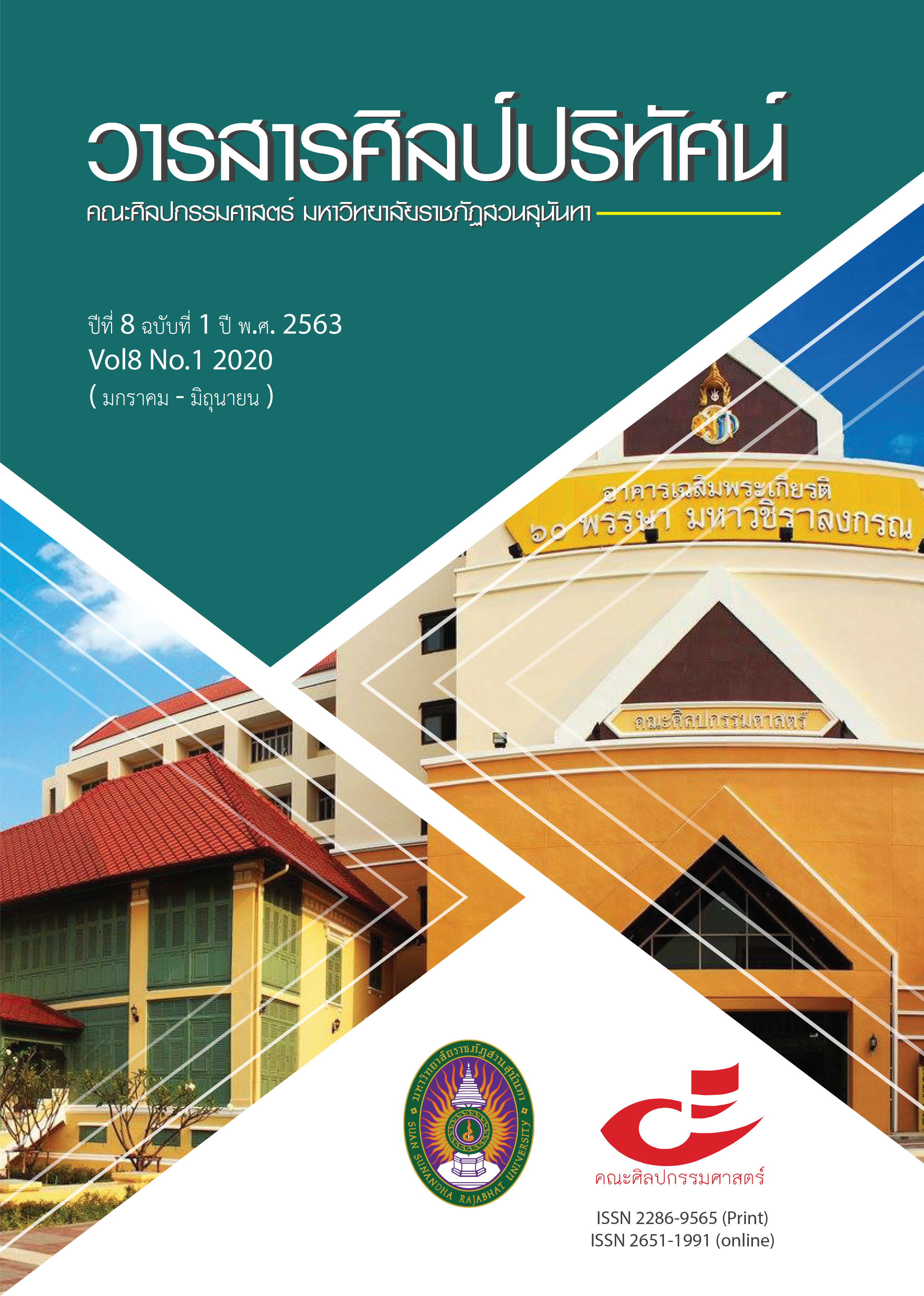เพื่อสืบสานจึงสร้างสรรค์
Main Article Content
บทคัดย่อ
ศิลปะผ้าปักไทยโบราณแบบราชสำนัก เป็นศิลปะรูปแบบไทยประเพณี วิวัฒนาการสืบทอดมาสู่ปัจจุบัน มีวิธีการปักและแบบแผนการสร้างลวดลายให้เกิดความงาม การปฏิบัติให้ความสุขสงบในสมาธิ แต่ในปัจจุบันมีผู้สืบทอดลดน้อยลง งานวิจัยนี้จึงศึกษาหลักการที่จะยืดอายุศิลปะดั้งเดิมให้อยู่ในความสนใจของคนปัจจุบัน ดำเนินการวิจัยโดยศึกษารวบรวมข้อมูลกับสัมภาษณ์ผู้เชี่ยวชาญวิเคราะห์ร่วมกับหลักศิลปะ นำกลวิธีการปักรูปแบบไทยประเพณีที่มีการปักวัสดุประดิษฐ์เป็นแม่ลาย ประกอบเป็นลวดลายที่มีแบบแผนซ้ำๆ ที่ให้ความรู้สึกสงบนิ่ง มาประยุกต์สร้างสรรค์เป็นศิลปะร่วมสมัย กำหนดเป็นกรอบแนวคิดความเปลี่ยนแปลงที่เกิดจากการเปลี่ยนแปรของรูปทรง โดยใช้หลักกฎเกณฑ์การเปลี่ยนแปรกับรูปทรงเป็นกรอบปฏิบัติ ด้วยวิธีการเปลี่ยนแปรรูปทรงซ้ำให้แตกต่าง 4 แบบ คือ รูปร่าง จังหวะ ขนาด ทิศทาง จัดวางบนแบบรูปที่เกิดจากเส้นโค้งคด ปักด้วยวัสดุที่มีค่าน้ำหนัก อ่อน – เข้ม แสดงเนื้อหาความงามในเอกภาพแห่งสภาวการณ์ความเปลี่ยนแปลงของลวดลายตามการคลี่คลายแปรเปลี่ยนและจัดวางรูปทรง
ผลการวิจัยพบว่า วิธีการสร้างสรรค์ผลงาน โดยการคลี่คลายรูปทรงให้แตกต่างจัดวางบนแบบรูปตารางที่เกิดจากเส้นโค้งคด ในสัดส่วน มาก-น้อย ส่งผลให้เกิดจังหวะเลื่อนไหลในระดับต่างๆ ผู้ชมผลงานสามารถรับรู้ ถึงความเปลี่ยนแปลงเคลื่อนไหวนั้นได้ ก่อให้เกิดความงาม ความสุข บนพื้นฐานประสบการณ์ที่ต่างกัน ประสานความคิดเชื่อมอดีตผ่านปัจจุบันไปสู่อนาคต ก่อเกิดเป็นความรักและแรงดลใจในแนวทางอนุรักษ์พัฒนาศิลปะไทยประเพณี
Article Details
เนื้อหาและข้อมูลในบทความที่ลงตีพิมพ์ในวารสารศิลป์ปริทัศน์ ถือเป็นข้อคิดเห็นและความรับผิดชอบของผู้เขียนบทความโดยตรง ซึ่งกองบรรณาธิการวารสารไม่จำเป็นต้องเห็นด้วย หรือร่วมรับผิดชอบใดๆ
บทความ ข้อมูล เนื้อหา รูปภาพ ฯลฯ ที่ได้รับการตีพิมพ์ในวารสารศิลป์ปริทัศน์ถือเป็นลิขสิทธิ์ของวารสารศิลป์ปริทัศน์
เอกสารอ้างอิง
กำจร สุนพงษ์ศรี. (2554). ศิลปสมัยใหม่ (พิมพ์ครั้งที่ 1-2). กรุงเทพฯ : วี.พริ้นท์.
กรมศิลปากร . (ม.ป.ป.). ตาลปัตร ฝีพระหัตถ์ฯ เจ้าฟ้ากรมพระยานริศรานุวัตติวงศ์. ม.ป.ท. : ม.ป.พ.
คณะอนุกรรมการจัดทำหนังสือ. (2557) “ราชพัสตราภรณ์” ในคณะกรรมการเอกลักษณ์ของชาติ ราชพัสตราภรณ์ (พิมพ์ครั้งท1). กรุงเทพฯ : อมรินทร์พริ้นติ้ง.
คณะทำงานพิพิธภัณฑ์ผ้า ในสมเด็จพระนางเจ้าสิริกิต์ พระบรมราชินีนาถ . (2529) . เครื่องโขน (พิมพ์ครั้งที1) . กรุงเทพ ฯ :โรงพิมพ์กรุงเทพฯ.
คณะช่าง. (2538). ภาพลายไทย (พิมพ์ครั้งที่ 11). กรุงเทพฯ : คอมม่าดีไซน์ แอนด์ พริ้นท์ จำกัด.
จักพันธุ์ โปษยกฤษ . (2540) . หุ่นวังหน้า (พิมพ์ครั้งที่ 1) .กรุงเทพฯ : โรงพิมพ์กรุงเทพฯ.
จักรพันธ์ วิลาสินีกุล (บ.ก.) .(2555) .ปัญญา วิจินธนสาร :ปรากฏการณ์ศิลปะไทยร่วมสมัย (พิมพ์ครั้งที่ 1) . กรุงเทพ ฯ : คมบาง.
ชลูด นิ่มเสมอ. (2554). องค์ประกอบของศิลปะ (พิมพ์ครั้งที่ 8). กรุงเทพฯ : อัมรินทร์พริ้นติ้งแอนด์พับลิชชิ่ง.
ณัฎฐภัทร จันทวิช. (2538). ตาลปัตรพัดยศ ศิลปบนศาสนวัตถุ (พิมพ์ครั้งที่ 1). กรุงเทพฯ : ริเวอร์ บุ๊ค.
ธีรพันธุ์ จันทร์เจริญ. (ม.ป.ป.). ผ้ายก. กรุงเทพฯ : อัมรินทร์พริ้นติ้งแอนด์พับลิชชิ่ง.
ปรีดา บุญยรัตน์. ( 2560). วิจัยเชิงปฎิบัติการ การสร้างสรรค์งานปักผ้าจากรูปแบบไทยประเพณีโดยใช้สื่อผสมเป็นผลงานศิลปะร่วมสมัย : แสดงความงามในเอกภาพแห่งสภาวการณ์ความเปลี่ยนแปลงของลวดลายตามการคลี่คลายแปรเปลี่ยนและจัดวางรูปทรง. วิจัยเชิงปฎิบัติการ ทุนสนับสนุนการวิจัย กองทุนวิจัยมหาวิทยาลัยธรรมศาสตร์ ประจำปีงบประมาณ 2560.
ปรีชา ช้างขวัญยืน. (2557). หลักการปกครองโดยธรรม (พิมพ์ครั้งที่ 1). กรุงเทพฯ : สถาบันพระปกเกล้า.
เผ่าทอง ทองเจือ (ผู้เรียบเรียง). (2549). ภูมิใจไทย (พิมพ์ครั้งที่ 1). กรุงเทพ ฯ : อมรินทร์-พริ้นติ้ง
เรนุกา สิงห์ (บ.ก.). (2545). จิตที่แปรเปลี่ยน (พิมพ์ครั้งที่ 1). กรุงเทพฯ : ส่องสยาม.
วิบูล ลี้สุวรรณ. (2559). พจนานุกรมผ้าและเครื่องถักทอ (พิมพ์ครั้งแรก). กรุงเทพฯ : สำนักพิมพ์เมืองโบราณ.
ศิลป์ พีระศรี. (2554). สุนทรียภาพและสาระในศิลปะ (ธานินทร์ สุนทรานนท์, ผู้แปล) (พิมพ์ครั้งที่ 1).
สันติ เล็กสุขุม. (2548). จิตรกรรมไทยสมัยรัชการที่ 3 : ความคิดเปลี่ยนการแสดงออกก็เปลี่ยนตาม (พิมพ์ครั้งที่ 1). กรุงเทพฯ : สำนักพิมพ์เมืองโบราณ.


